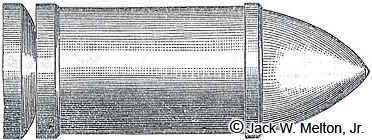Dr. John B. Read’s Safety Groove
During Read’s public experiments at Fortress Monroe and at West Point in 1858-59 he discovered that a groove was needed between the sabot and cylindrical iron body. His experiments at Fortress Monroe were with a 24-pounder gun and at West Point (on the West Point Foundry side of the Hudson River) hundreds of projectiles were fired from 24- and 32-pounder guns, and a few from a 9-inch Navy gun and a 10-inch Columbiad. During these experiments there was no "...occurrence of any such breaking, provided the safety grooves had been left sufficiently open in founding." Ordnance officers were at the time not aware of the purpose of this groove and "...suppose it was intended to hold lubricating substances. It answers well, of course, for this purpose, but its object was much more important." This groove was called a "safety groove" and was closed by the shock of the initial propellant charge which drove the sabot forward relieving the base of the shell. Also this groove helped to prevent the sabot from jamming itself against the bottom of the outer cylindrical surface of the projectile. Some of the projectiles that were manufactured without this groove have been recovered with chips or wedge-shaped pieces broken from the initial force of the shock from the sabot.
"It is true that the slow burning powder now employed for ordnance, diminishes the danger of breaking and jamming shells unprovided with any safety grooves, but it is by no means obviated, as shown by occasional accidents from this cause within the last few years, even in the deliberate practice of target firing. But the heated state of the guns, that would be produced by the rapid firing of an engagement, would greatly intensify the shock of the charge, as is well known to all artillerists, and thus greatly augment the very serious danger that has now been so fully described. If experience in ordnance has demonstrated anything, it would seem to be, that the use of heavy rifle guns in battle, firing shells without safety grooves, would be liable to the almost certain recurrence of some of the disasters attending the bombardment of Fort Fisher, when the bursting on board the Federal fleet of rifle guns [bursting of Parrott rifles], using unprotected shells, inflicted more damage upon officers and men than was sustained from all the fire of the invested fort." Not only were these wedge-shaped pieces dangerous to friendly troops but the gunners had to worry about the projectile being jammed in the gun.

"The annexed cut above represents the form usually assumed by Dr. READ’S projectile. Encircling the base of the shell, and between it and the bottom of the sabot, will be seen the indispensable safety groove, invented by him after the issue of his patent [October 28, 1856, United States Patent # 15,999], and used in his public experiments in 1858--9."
All quotes are from Senator Howard’s views extracted from the Report of the Committee on Military Affairs in 1870.
For more information about Dr. John Read click here.